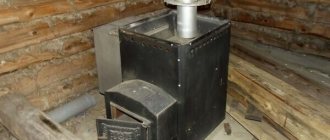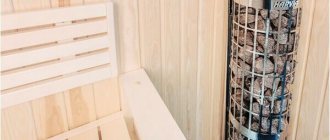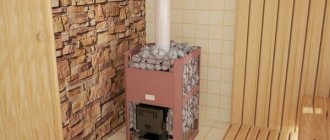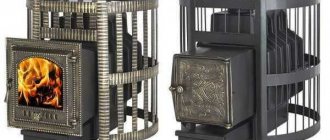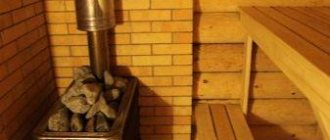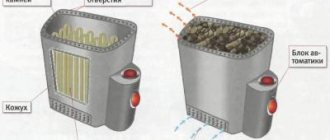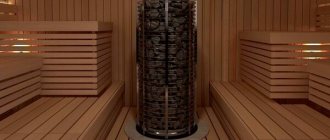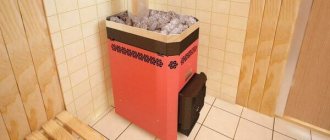Distinctive features
Feringer stoves correspond to real stone stoves.
Absolutely all devices have distinctive branded features:
- burning from top to bottom;
- air is supplied through separate channels at the top of the heat-resistant door;
- The stoves do not have a grate or an ash pan.
Sauna and steam bath stoves have several modes:
- Finnish dry sauna - work with an open valve;
- express drying of a steam room - with an open valve and a strong fire;
- Russian stove - with a closed valve, direct contact of the air with the stone lining of the unit;
- Blowing the heater - to regulate the power of hot air.
Design of Feringer stoves with a closed heater
In general, the firebox is formed mainly by stamping and bending methods, and has a minimum of seams. The seams are located in places with low temperature loads. All furnace elements are made of stainless steel with 17% alloy metal content.
In stoves with a closed heater, a cylindrical container for stones rests on the base of the stove and covers the firebox on all sides (except for the front part, where the extension or firebox door is installed). To regulate the air flow passing through the heater, there is an adjustable damper. With its help, you can reduce or increase the heating rate of the steam room. While intense heating is taking place, the damper is opened and hot air quickly warms up the room. The steam room is dried in the same position after the bath.
Construction of a furnace for a Feringer bath with a closed heater
When the required temperatures are reached, the damper closes completely or almost completely. The temperature is stabilized and the steam room conditions are maintained in the specified mode.
A smoke tooth is installed in the upper part of the firebox. This is a metal piece curved in the shape of the letter “L” at the top of the firebox. It allows you to twist streams of smoke and flame into a spiral. Because of this, the walls of the firebox warm up better, and the stones warm up from it. This tooth gives another positive result: the flame rises in the pipe only 30-70 cm (in stoves of a conventional design, the height of the flame in the pipe exceeds a meter, and sometimes one and a half to two).
Adjusting the combustion intensity
There is an adjustable damper above the door (1) and below it (2).
The burning speed of firewood can be changed by two dampers. One is located above the firebox door, the second below it. It is advisable not to close the upper damper completely: it ensures that there is no soot on the glass. Always leave at least a minimum gap of a couple of millimeters, and the glass on the door will always be clean.
These two dampers regulate the amount of air supplied to the firebox. The more air, the more actively the wood will burn. This mode is necessary at the stage of heating the steam room and stones. Then, when the temperature is close to the required one, they cover themselves and the wood smolders, maintaining the temperature of the stones and practically stopping the heating of the steam room.
Getting steam
Deep inside the heater is a device called a steam gun. This is an L-shaped tube with holes. Another tube is welded to it, which goes to the top of the heater. Water is supplied to it and converted into steam.
This is how a steam gun works
Through small holes in the horizontal tube, water flows into the hottest part of the heater - onto the lower stones. Their temperature is 500-550°C. As a result, tiny droplets are formed, which have a high temperature at the outlet. They are very small, they are almost invisible. This state of steam is called “light”. Probably because after vaping you feel light in your body and never have a headache.
Adjusting the temperature in the steam room
The atmosphere in a steam room consists of many components. The air and walls warm up from the radiation of the stove body and pipe, from the steam that is supplied to the heater. You need to change the temperature in the steam room by manipulating the modes of these elements. There are dampers/gates for this.
How to adjust the combustion intensity and heat transfer of the housing has already been explained (using the valves near the door). It is also necessary to control the air flow through the chimney convector. For this purpose, there is also a valve/gate in its upper part. By moving its handle to the right/left, you open/close, completely or partially, the lumen of the air tubes.
Devices for adjusting combustion intensity
The new Feringer stoves of the Lamel series have another powerful tool: the heater ventilation valve. At the initial stage, when the stones warm up, it is closed. The heater in this position is unventilated and the stones heat up to high temperatures. Then, to quickly reach the desired temperature, the valve opens. The air, passing through the stones, heats up greatly, quickly bringing the steam room to the desired mode. Once the required temperature is reached, the valve closes again and the stones are heated to produce steam.
While this is happening, the walls, floor, ceiling, and shelves are warming up in the steam room. As bath experts say: the steam room is infused. The temperature background of all its parts is equalized. It is in this state of affairs, when heat comes from the walls, and from the shelf, and from the ceiling, that the body warms up deeply. There is no heat. You feel only an even warmth that does not burn, like in a dry air vent, but envelops you, warming you up.
This is a live steam gun
The temperature drops slightly. But if it is within the normal range (50-55°), there is no need to raise it again: with each supply of steam it will jump by about 5°C. So, if you raise the humidity, you will also raise the temperature. And before steaming with brooms, you need to warm up two or three more times. During this time, it will grow another 10-15 degrees.
Types of devices and their brief description
Feringer stoves are made for saunas and baths.
Depending on their purpose, they are divided into devices:
- with a closed heater, “steam installations” for a bath . The internal structure of such units is the same, only the size differs. Such baths have either a panoramic screen or doors made of glass or cast iron and are called “Lamel”, as well as “Steam ovens”. The Russian bath mode, at the same time, can be provided by three categories: Malyutka for small steam rooms up to 16 cubic meters;
- Classic steam room for medium-sized rooms - up to 18 cubic meters;
- Harmony - for large steam rooms up to 30 cubic meters.
- Baby - for a steam room up to 16 cubic meters;
Advantages and disadvantages
If we compare Feringer stoves for the “Russian bath” with heating equipment from other manufacturers, we will find a number of significant advantages:
- stylish outer casing;
- high energy efficiency of the device;
- guarantee of fire safety of the company's furnaces;
- there is no need to constantly clean the oven glass;
- high quality of materials and paint used to cover the body;
- complete tightness when the equipment door is closed;
- the ability to control the air supply during operation of the furnace.
- damper made of a gate, which reduces draft when the door is closed;
- uniform burning of wood in the product.
As such, there are no visible shortcomings in Feringer bath and sauna stoves, however, some users note that over time, on some models, the door latch begins to work poorly.
NOTE!
Also in the ovens there is a hole for laying stones that is too narrow for a human hand (you must use tongs).
Advantages of purchasing a Feringer sauna stove
Considering the main advantages available to buyers of Feringer heating equipment, it is worth highlighting:
- ease of use;
- excellent wear resistance, durability;
- ease of installation and assembly;
- the originality of the appearance of the heating device, in particular the presence of glass;
- fuel economy due to the characteristics of its combustion;
- minimizing the deposition of soot on the surface of sauna stove elements;
- premium quality at an affordable price;
- use of natural stone and heat-resistant steel AISI 439 in design;
Brand series
Two popular and unique series of stoves for baths and saunas differ significantly from other manufacturers.
The brand has two types of equipment:
- Series "Lamelle". Such stoves have a beautiful finish made of natural stone. Stone lamellas can even be used in cladding the walls surrounding the heating device. Such units have a closed heater - first the stones are heated, then the steam room itself heats up from them. Thanks to the “Upper Ignition” combustion system, such stoves are very economical - one load of firewood is enough to heat a room for 3-4 hours. The Lamel series has several types that are suitable for different room sizes: Mini, Optima, Maxi. Facing lamellas can be made from the following types of natural stone: serpentine, jadeite, Silviaro marble, Rossolevante marble. There are often combinations of different types of stones in one piece of equipment.
- Series "Steam ovens". Devices of this type help create ideal conditions for a true Russian bath, because a large amount of soft, fine steam heals the body. This type of oven does not have a grate, which simplifies the process of maintaining the equipment. An important feature of “Steam stoves” is maintaining the most comfortable temperature for a person in a steam bath. This series also varies in size: Baby, Classic, Harmony.
- The “Golden Ratio” is a wood-burning stove for saunas. They have three subtypes, depending on the volume of the room: Malyutka, Classic, Dobrynya. The firewood should be short in length and should be stacked on top of each other, filling only 3/4 of the stove. You can use chopped pieces of firewood.
Design features
The first thing that catches your eye is the elongated shape and a rather voluminous firebox. Moreover, if you look at the Feringer sauna stove in a horizontal section, it turns out that the firebox is surrounded by stones on almost all sides. And the heat from the wall of the firebox is transferred to the stones, from them the screen is already heated, and then the room is heated by radiant heat from the screen. Therefore, there is no need to cover this metal stove with a brick screen, as is done when installing the vast majority of other models (the exception is the Kutkin stove).
Feringer furnace section
Another feature is the firebox without grates. This is because the top combustion principle is used. With this option, the firewood is lit not from below, as we are used to, but from above. This principle makes it possible to use the heat from burning wood to the maximum. In this position, the coals are constantly in the combustion zone. As a result, there are almost no unburned residues. If there are a few coals left, then only those that burned last.
The next design feature is the presence of a smoke tooth and a side combustion system. They also ensure that more heat goes to warming up the heater rather than escaping into the chimney. The side burning system is a special design in the firebox in which the coals do not lie in the center, but are scattered throughout the stack, igniting the wood lying on the side. After all, in wood-burning stoves this is the zone that burns the worst. In Feringer stoves, the entire surface of the wood burns.
The smoke tooth, located in the upper part of the firebox, twists the flame at the top in a spiral (look at the photo). In this way, the flame stays in the firebox longer, heating up the walls more strongly, and small remnants of it end up in the pipe. But the heat that inevitably ends up in the chimney can be used to heat the steam room. For this, Fehringer has several solutions:
- A heater on a pipe in a traditional and non-traditional design: with a mesh or a decorative carved screen.
- Controlled convector on a pipe. This is a device with a duct system around a main metal pipe.
Diagram of air movement during furnace operation
When installing a controlled convector at its very bottom, immediately after the stove is lit, boiling water is poured. As flue gases pass through, water turns into steam and enters specially formed lamella channels. Since moist air (steam) has a large heat capacity, passing along the wall, it takes away and transfers more heat. These flows contribute to faster heating of the steam room. But this device should only work during the warm-up stage. When they start steaming, it is closed (by turning the damper). By this time, all the water in the convector should have boiled away.
TOP 3 best stoves for Feringer baths
MINI
Feringer MINI offers a choice of 10 types of cladding with various stones . The combustion chamber is made of heat-resistant stainless steel, the door is equipped with a viewing glass.
The MINI model can be used in rooms with a volume of up to 16 cubic meters.
The model includes a phytocontainer for aromatherapy and a steam gun, which will help make your sauna experience feel like visiting a spa salon.
Specifications:
- heating room volume - 16 cubic meters;
- power - 16 kW;
- view - closed;
- presence of a chimney - yes;
- fuel - firewood;
- outer casing - steel;
- door material - heat-resistant glass;
- combustion chamber material - steel;
- connection to the chimney - top;
- dimensions - 44.50*80*81 cm;
- weight of stones - 80 kg;
- weight - 120 kg.
Advantages:
- minimum convection in the oven;
- stylish design;
- creates good steam.
Flaws:
- A certain size of firewood is required, shorter than standard ones.
OPTIMA
This stylish stove is completely new (2019) . The model is perfect for a steam room that needs to be equipped in the form of a Russian bath. The volume of the room should be no more than 18 cubic meters.
Type of heater: closed, capable of holding up to 100 kg of stones.
The stove unit is installed “through the wall”, that is, the heater is located in the room, and the remote portal is in the next room.
Specifications:
- heating room volume - 18 cubic meters;
- power - 20 kW;
- view - closed;
- presence of a chimney - yes;
- fuel - firewood;
- outer casing - steel;
- door material - heat-resistant glass;
- combustion chamber material - steel;
- connection to the chimney - top;
- dimensions - 57*85*92 cm;
- weight of stones - 100 kg;
- weight - 125 kg.
Advantages:
- possibility of facing with 10 types of stones;
- installation using the “through the wall” method.
Flaws:
- high cost of the product.
MAXI
Feringer Maxi - sauna stove with stone lining . Such a device will help to improve the health of the body, improve well-being, and improve the health of the body with soft, weightless and enveloping steam, like a cloud.
The large Feringer stove was created not only so that a person can wash himself, but also feel light and calm . The unit is designed for large rooms up to 30 cubic meters; the fuel for the “Russian bath” stove is firewood.
The user can choose any of 10 colors for lining the equipment.
Specifications:
- heating room volume - 30 cubic meters;
- power - 25 kW;
- view - closed;
- presence of a chimney - yes;
- fuel - firewood;
- outer casing - steel;
- door material - heat-resistant glass;
- combustion chamber material - steel;
- connection to the chimney - top;
- dimensions - 63.50*95*97.50 cm;
- weight of stones - 150 kg;
- weight - 171 kg.
Advantages:
- steam gun and phytocontainer included;
- Excellent fuel economy;
- modern and reliable design solutions.
Flaws:
- high cost of the product.
Customer Reviews
Marina Alekseeva: “The Feringer brand Mini stove burned out after 3 years. The steam was good, but such a low-quality device is not worth the money; it burns out very quickly. It is better to buy cast iron and also in stone. By the way, you need firewood of a certain size, not too big.”
Sergey Ivanovich: “Fehringer Optima has a number of advantages, and most importantly, installation yourself will not take much time. I installed the stove at my parents’ summer cottage, everyone is happy. The cast-iron body retains heat well, which saves on fuel.”
Igor Kuznetsov: “We have a Feringer stove, a subtype of Maxi, which can only be installed in large rooms, approximately 30 cubic meters. It's been in service for probably 7 years now. Not only the stone decor is interesting, but also the quality of the unit - for several years now, every weekend we have been going to steam with friends, the stove is still working properly.”
